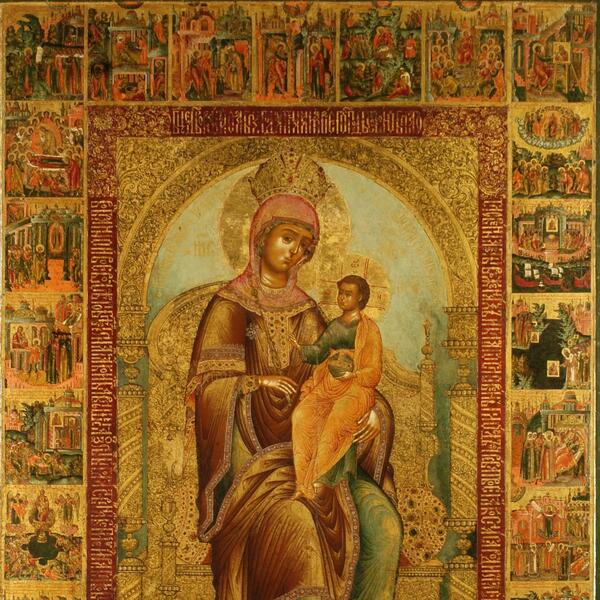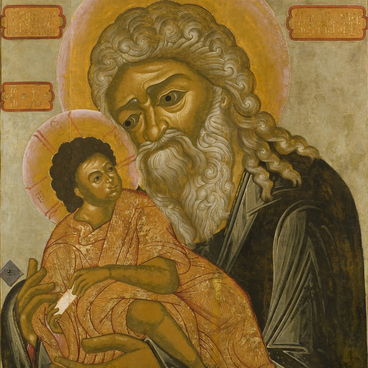This icon was created for the local tier of the iconostasis at the Church of St. John Chrysostom in Korovniki. It is based on the writing known as “The New Heaven Created with New Stars, or the Most Holy Mother of God and Her Miracles”. The author is the Ukrainian religious scholar and preacher Ioanniky Galyatovsky. The work was translated into Russian in 1677 and reprinted two more times in the 17th century.
Semyon Spiridonov Kholmogorets was the regular icon painter at Kholmogory and worked in many towns and monasteries across northern Russia. He fulfilled two commissions of the royal court in Moscow — in 1666 and 1678. For many years, Semyon Spiridonov worked in Yaroslavl. His iconographic style features traces of the Stroganov school’s traditions. The numerous miniature scenes are filled and sometimes even overfilled with information. This refers to the idea that the world is full of holy actions and events. This worldview was popular during the artist’s lifetime.
The Infant Christ sits on the left hand of his Mother. The orb in his left hand is a symbol of the Lord of the World and his redemptive sacrifice. Jesus raises his right hand in a gesture blessing the true God-Bearing Temple.
The composition of border scenes reveals the precreation plan of God. They illustrate the life of the Virgin Mary from Isaiah’s prophecy about her birth to her Dormition and Assumption. These are followed by the miracles of Greek and Russian icons of the Mother of God, and hymnographic border scenes. Some of the miniatures are dedicated to the Virgin Mary being the protectress of Russian lands (the Intercession, the arrival of Greek painters to the Kyiv-Pechersk Lavra, and the Battle of the Novgorodians with the Suzdalians). The four lower scenes are based on the hymn by John Chrysostom “It is Truly Meet…” and reflect the concept of Sophiology which is typical of Yaroslavl fresco painting of that period.
Particularly important is the counter-position of the upper and lower central border scenes — the Annunciation and Joy of All Who Sorrow (with the latter being highlighted by the white color of the light of paradise). This decision emphasizes the idea of the Virgin Mary as the altar of sacrifice and the God-Bearing Human Temple.
Semyon Spiridonov Kholmogorets was the regular icon painter at Kholmogory and worked in many towns and monasteries across northern Russia. He fulfilled two commissions of the royal court in Moscow — in 1666 and 1678. For many years, Semyon Spiridonov worked in Yaroslavl. His iconographic style features traces of the Stroganov school’s traditions. The numerous miniature scenes are filled and sometimes even overfilled with information. This refers to the idea that the world is full of holy actions and events. This worldview was popular during the artist’s lifetime.
The Infant Christ sits on the left hand of his Mother. The orb in his left hand is a symbol of the Lord of the World and his redemptive sacrifice. Jesus raises his right hand in a gesture blessing the true God-Bearing Temple.
The composition of border scenes reveals the precreation plan of God. They illustrate the life of the Virgin Mary from Isaiah’s prophecy about her birth to her Dormition and Assumption. These are followed by the miracles of Greek and Russian icons of the Mother of God, and hymnographic border scenes. Some of the miniatures are dedicated to the Virgin Mary being the protectress of Russian lands (the Intercession, the arrival of Greek painters to the Kyiv-Pechersk Lavra, and the Battle of the Novgorodians with the Suzdalians). The four lower scenes are based on the hymn by John Chrysostom “It is Truly Meet…” and reflect the concept of Sophiology which is typical of Yaroslavl fresco painting of that period.
Particularly important is the counter-position of the upper and lower central border scenes — the Annunciation and Joy of All Who Sorrow (with the latter being highlighted by the white color of the light of paradise). This decision emphasizes the idea of the Virgin Mary as the altar of sacrifice and the God-Bearing Human Temple.


